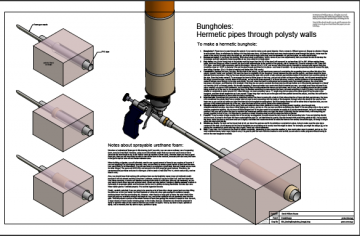Location
My gift to you, world. Take it and make marvelous, insulated, any-size, liquid-containing thingies, including, like, digesters.
Click here for the PDF. Hey, it’s yours!
As some of you know, I have been working hard for quite some time to develop a completely new option for biogas: poly-panel digesters. These are digesters where ‘the insulation is the container’. They are built from polystyrene insulation panels (the pink stuff, right?) supported by inexpensive wood (mostly 2x4s). The polysty sheets, cut to size, are welded to other bits of polysty using urethane foam, such as ‘Great Stuff’, or using certain kinds of caulks. These digesters are easily heated, they can have any of several kinds of agitation, and they are inexpensive.
My intention is to sell these drawings, which should offer every detail necessary to build this new design, the very first poly-panel digester, a 1.3 cu m (slurry volume) unit I call ‘[The_Cube]’. After all, it has taken a great deal of time and has cost me deep in the purse to do the experiments required to produce this design. I want to work with the poor, but I need to pay down my mortgage (et al) or I will not have been responsible to my obligations and my family. This venture is my method for meeting those obligations.
At the same time, I want to offer, freely and to all, some of the general techniques and ideas which we have developed. For example, one of the many advantages of the poly-panel digesters is that it is very easy to put pipes through the walls of the digester, hermetically. [The_Cube], for example, has 10 pipes going through its walls, base and top (inlet, effluent, drain, hot water in and out, recirculation of effluent, and four pipes in the GCS— gas collection system). [Late note, 4/10/19: You can get a draft copy of the drawing set, here.]
This technique is quick and cheap. With the proper tools and knowledge, it can be done in a two or three minutes, really. And if you don’t count the cost of the pipe and polysty, the hermetic seal costs… pennies, because the sum of what you are investing is a small quantity of the urethane foam in a can or canister. Do-it-yourself uniseals?
So that’s my plan: sell the specifics, and offer many techniques for free. I think that’s more than fair, don’t you? You get what I think is pretty valuable knowledge, just because you can breathe, and yet I can still make a noble living— what I hope can be counted as a right livelihood, speaking in Buddhist terms. I am happy to provide benefit to those who want to carry things in their own hands, walking in their own direction.
So: Would you like to know how to make hermetic bungholes for poly-panel digesters? Well, whether or not, I'm going to freely give that information away by sharing one of the simpler drawings from the package with you. (Visit the link above or below to get the linked PDF.) It is my gift to you and, I do hope, one of many gifts which will come from this work. If you like, you can get a copy of The Complete Biogas Handbook on this site, because it is sales of that book (at present) which fund the research for pushing the evolution of the design for [The_Cube] and other digesters (watch this space!) forward.
I should also mention that the drawings in [The_Cube]’s package are like architectural blueprints. I drew them on a ‘virtual’ sheet of paper that is ANSI D size (22"x34"), because in general, the amount of detail provided requires these larger sizes. (I tell you this because if you print the PDF on a standard sized sheet of paper, it may be rather hard to read.)
Finally, then, if you want to keep up to date with progress on [The_Cube], I suggest you sign up on our email list (above and to the right). The messages that will come from us will be rare, but (I hope) worth your while.

